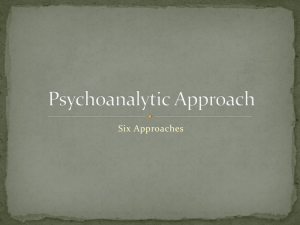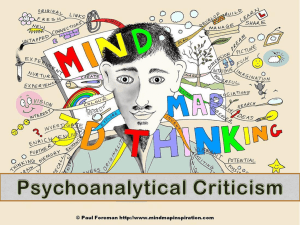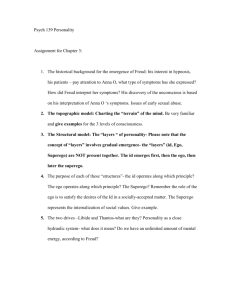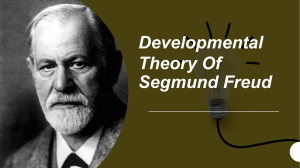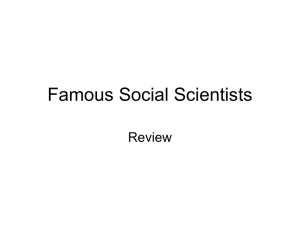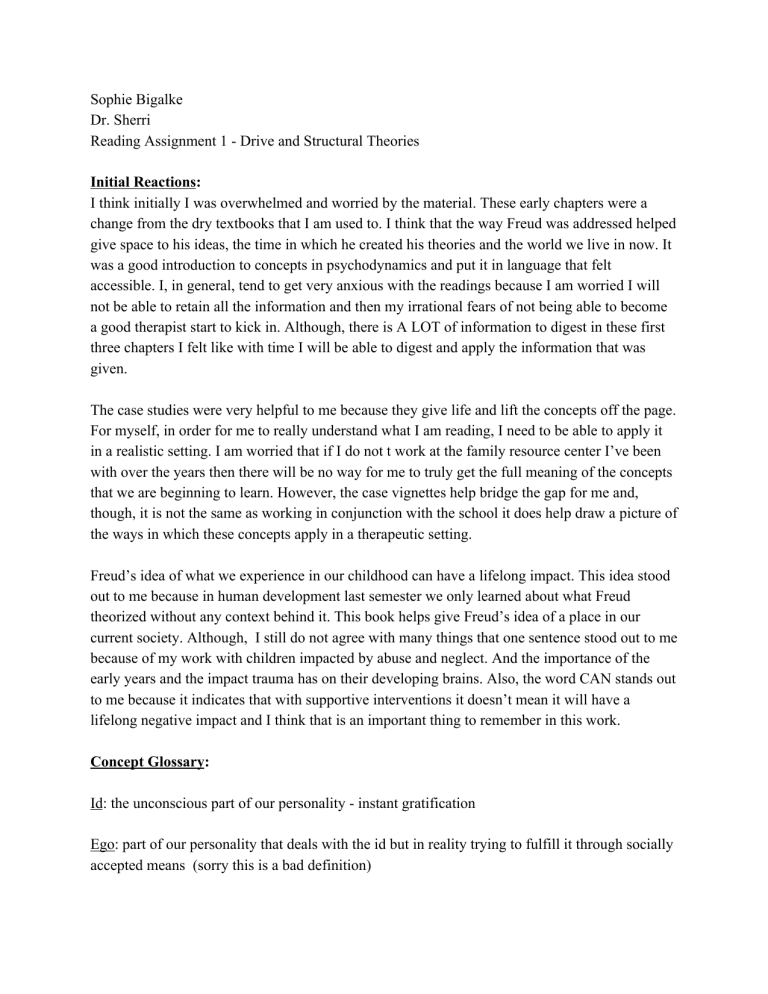
Sophie Bigalke Dr. Sherri Reading Assignment 1 - Drive and Structural Theories Initial Reactions: I think initially I was overwhelmed and worried by the material. These early chapters were a change from the dry textbooks that I am used to. I think that the way Freud was addressed helped give space to his ideas, the time in which he created his theories and the world we live in now. It was a good introduction to concepts in psychodynamics and put it in language that felt accessible. I, in general, tend to get very anxious with the readings because I am worried I will not be able to retain all the information and then my irrational fears of not being able to become a good therapist start to kick in. Although, there is A LOT of information to digest in these first three chapters I felt like with time I will be able to digest and apply the information that was given. The case studies were very helpful to me because they give life and lift the concepts off the page. For myself, in order for me to really understand what I am reading, I need to be able to apply it in a realistic setting. I am worried that if I do not t work at the family resource center I’ve been with over the years then there will be no way for me to truly get the full meaning of the concepts that we are beginning to learn. However, the case vignettes help bridge the gap for me and, though, it is not the same as working in conjunction with the school it does help draw a picture of the ways in which these concepts apply in a therapeutic setting. Freud’s idea of what we experience in our childhood can have a lifelong impact. This idea stood out to me because in human development last semester we only learned about what Freud theorized without any context behind it. This book helps give Freud’s idea of a place in our current society. Although, I still do not agree with many things that one sentence stood out to me because of my work with children impacted by abuse and neglect. And the importance of the early years and the impact trauma has on their developing brains. Also, the word CAN stands out to me because it indicates that with supportive interventions it doesn’t mean it will have a lifelong negative impact and I think that is an important thing to remember in this work. Concept Glossary: Id: the unconscious part of our personality - instant gratification Ego: part of our personality that deals with the id but in reality trying to fulfill it through socially accepted means (sorry this is a bad definition) Superego: it deals with moral values and ego and superego could come to same decision but there is a moral component with the superego/ Freud believed it emerges during the genital stage. It develops last. The unconscious: this is what is outside the conscious awareness in all individuals including thoughts and urges. Repetition compulsion involves unconscious material. Repetition compulsion: repeating behaviors and experiences that we can’t understand or assimilate into our bodies → we repeat what is in our unconscious. Working through: moments of transformation through talking and somatically working with whatever is stuck. This happens in session or for example for us right now in classes that we are taking, Our ability to work through helps in our ability later on to be better therapists who are mindful when our own stuff comes up while in session with clients. As humans, we will always be working through → a life-long process Transference: when a client’s feelings or desires or experiences from their past relationships are transferred onto the therapist in session by the client. Transference happens within other relationships, such as intimate relationships. Resistance: pushed away thoughts desires, urges that are not acceptable. Repression: the ability of us as humans to push the ideas and desires that we have as far down out of consciousness; we do this through unconscious means. Sometimes it is a survival instinct due to trauma. Conversion: different from compliance in that it is not conforming. It is convincing that views are correct of minority group. Countertransference: when the therapist’s inner unresolved feelings, conflicts, etc. come up during session in response to a client’s own history or beliefs or feelings or behaviors. Reference: Berzoff, J., Flanagan, L. M., Hertz, P., & Berzoff, J. (2016). Inside out and outside in: Psychodynamic clinical theory and psychopathology in contemporary multicultural contexts (Ch 1-3). Lanham, Md: Jason Aronson. Two questions: 1. Does the Id correlate to instinct? 1) How can we work with dream analysis when it is repressed so much? Does it only work when we can remember or is there a way to trigger our dreams to come back into our memory?
